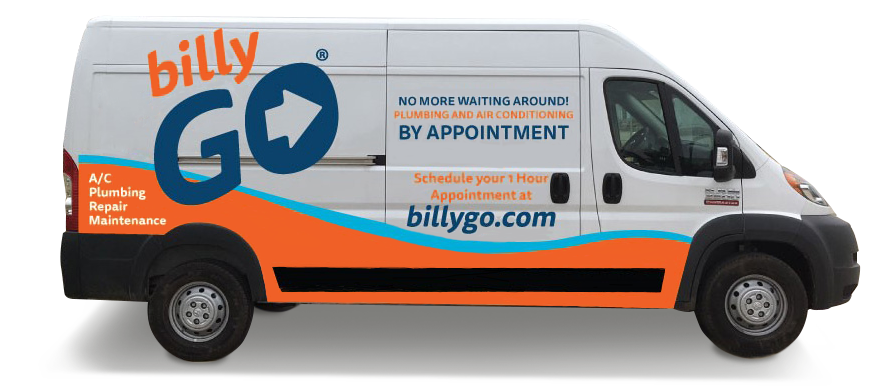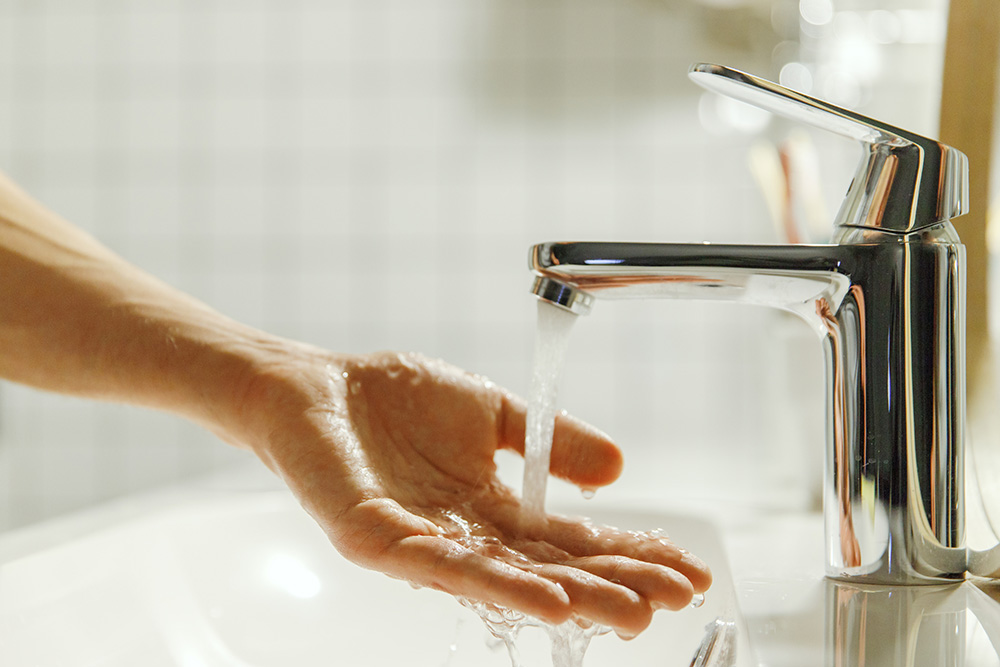The quest for a way to get instant hot water at the faucet or shower is a common one. It might not be as universal as something like the search for the meaning of life, but the possibility of instant hot water has crossed the mind of just about everyone who has watched water run down the drain while waiting for it to heat up.
It’s an inconvenience, obviously, when you must wait for the water you need. It can even make you feel a little guilty when you see how much water is wasted, although probably not guilty enough to step into an ice-cold shower in the morning.
Fortunately, there are some solutions to the longstanding problem of waiting and wasting. Four ways to get instant hot water at the faucet are a recirculating system, a demand system and point-of-use water heaters in both tank and tankless forms.
Why Does It Take So Long to Get Hot Water to My Faucet?
 To better understand ways to get instant hot water, let’s start with why it can take so long for the water coming out of the faucet to be heated. While a water heater’s age and efficiency can be a factor, along with the level of insulation of a home’s pipes, the biggest reason is pretty simple:
To better understand ways to get instant hot water, let’s start with why it can take so long for the water coming out of the faucet to be heated. While a water heater’s age and efficiency can be a factor, along with the level of insulation of a home’s pipes, the biggest reason is pretty simple:
The cold water sitting in the pipes must be flushed out before the hot water can get to the faucet.
After leaving the hot water heater, the heated water must travel through a system of pipes to get to the faucet. In front of that heated water is the water that has been chilling in the cold pipes since the last request for hot water.
In some cases, the trip from the water heater to the faucet is a long one. For example, think about a common two-story home in Texas. If the water heater is installed in the attic, the upstairs faucets and showers might not need long for water to turn hot at the faucet. But for the kitchen and bathroom faucets and showers downstairs, it can take a minute or two for the water to get where it’s needed. It can take even longer during the winter because the first gallon or two of water is cooled as it travels through the very cold pipes.
So, What Are the Options to Get Hot Water Faster?
Each homeowner’s needs are different, so the options are not “one size fits all.” But here are four ways to get instant water at the faucet.
1. Recirculating Hot Water Systems
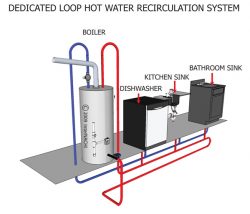 With the traditional tank water heater, turning the knob at the faucet starts the process of hot water making its trip through the pipes. But what if the water in the pipes is already heated when the request is made?
With the traditional tank water heater, turning the knob at the faucet starts the process of hot water making its trip through the pipes. But what if the water in the pipes is already heated when the request is made?
In that case, hot water is at the faucet instantly.
A recirculation system connects the farthest point of a plumbing system back to a water heater with a plumbing line that becomes a dedicated loop of hot water. Hot water is always circulating through the system, so it is available at every faucet immediately, as shown in this illustration by InterNACHI, a manufacturer of recirculating hot water system equipment.
The greatest benefit of the system is immediate hot water at every faucet and showerhead, which saves time and reduces the amount of wasted water. Water recirculation systems are often activated by a thermostat, which turns on the system when the water cools below a certain temperature. They can also be activated by a timer, which can turn off the system for times when the home is empty or hot water isn’t needed, saving money on utility bills.
2. Demand Hot Water Systems
When building a new home, a buyer might ask that the plumbing system be designed with the recirculation system that requires a dedicated loop of hot water. But can you have a recirculating system if your house isn’t plumbed for it?
 The recirculation system described above could require significant changes to existing plumbing. A demand system, however, works much like a recirculating system and can be retrofitted into existing homes.
The recirculation system described above could require significant changes to existing plumbing. A demand system, however, works much like a recirculating system and can be retrofitted into existing homes.
With a demand hot water system, a pump is attached to hot and cold water lines under the kitchen or bath fixture that is farthest from the water heater. At the press of a button, the cool water that normally runs down the drain is recirculated back to the water heater through the cold water line and water from the hot water heater is brought to the faucet.
When the temperature of the water at the farthest fixture gets heated to the right temperature, the pump stops because the water lines are filled with water.
3. Point-of-Use Tank Water Heaters
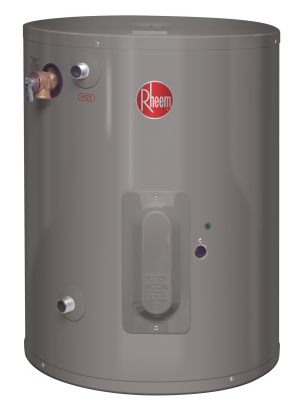 A point-of-use water heater is exactly as its name suggests, providing a water heating source very close to where a sink, shower or bathtub is located. Point-of-use water heaters are often used to heat water at a fixture that is a long way from the home’s tank water heater. They can also be used to heat water at a spot where immediate hot water is most needed or convenient. Point-of-use water heaters can be integrated into an existing plumbing system.
A point-of-use water heater is exactly as its name suggests, providing a water heating source very close to where a sink, shower or bathtub is located. Point-of-use water heaters are often used to heat water at a fixture that is a long way from the home’s tank water heater. They can also be used to heat water at a spot where immediate hot water is most needed or convenient. Point-of-use water heaters can be integrated into an existing plumbing system.
A tank point-of-use water heater is like the traditional whole-home tank water heater, but the water tank is smaller. Tank point-of-use water heaters come in sizes from 2.5 gallons to 20 gallons, depending on the level of demand for hot water. They are excellent at providing instant hot water because they eliminate the distance the water needs to travel to fixtures. Installing a point-of-use tank water heater is a great way to save time, water, and money.
4. Point-of-Use Tankless Water Heaters
Just like the whole-home tankless water heater, this water heater only operates when there is a demand for hot water. While tank water heaters store heated water to be sent to a faucet upon request, a tankless water heater starts working after the request is made.
When a hot water tap is turned, cold water travels through a pipe into the tankless water heater, which then heats the water with an electric element or gas burner.
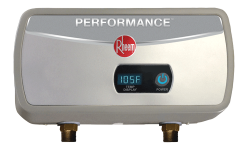 Tank water heaters are measured by storage capacity, whereas tankless water heaters are measured by the gallons of water they can heat per minute. (Most tankless point-of-use water heaters are rated at between 2.0 and 2.5 gallons per minute. Here’s a handy estimate of the flow rate needed for showers, sinks, washing machines, etc.)
Tank water heaters are measured by storage capacity, whereas tankless water heaters are measured by the gallons of water they can heat per minute. (Most tankless point-of-use water heaters are rated at between 2.0 and 2.5 gallons per minute. Here’s a handy estimate of the flow rate needed for showers, sinks, washing machines, etc.)
As with a point-of-use water heater that includes a tank, a tankless point-of-use water heater can provide nearly instant hot water because of its location near the fixture that needs the hot water. It should be noted, however, that tankless water heaters cannot provide heated water as quickly as a tank water heater because there is a delay of a few seconds before water from a tankless water heater reaches the target temperature. Also, must tankless point-of-use water heaters are electric, which heats water slower than a gas flame. The tankless point-of-use-water heater shown here is less than 11 inches wide, six inches high and 2.75 inches thick, so it can be mounted in tight quarters beneath nearly any sink. Installing a point-of-use tankless water heater is a great option if endless hot water sounds appealing, if space is a concern, or you are interested in modern smart features.
Don’t All Tankless Water Heaters Provide Instant Hot Water?
Yes, they do – and no they don’t.
Tankless water heaters start heating water the moment you turn on the faucet, so it’s understandable why some people believe tankless water heaters provide hot water on demand. But just like a tank water heater, a tankless water heater faces the same geography challenge of getting the heated water through the pipes and to the faucet where it’s needed. Anyone who switches to a tankless water heater with the expectation of getting a gusher of hot water each time he or she turns the faucet is going to be disappointed.
This is not to say that tankless water heaters don’t offer some wonderful benefits, the biggest being a never-ending supply of hot water (as long as there aren’t so many faucets and appliances demanding water at the same time that it exceeds the water heater’s flow rate). But while tankless water heaters don’t have a tank that can run out of hot water, the heaters can’t get the heated water through the pipes any more quickly.
If your tank or tankless water heater is in an attic above the second floor of your house and your shower is on the first floor, you’re going to have to wait for hot water unless you use one of the options above.
Can a Water Heater Booster Help Me Get Hot Water Faster?
This is another question that some people have, and unfortunately, the answer is no.
A tank water heater booster is a device that is installed directly to a water heater to increase the amount of heated water a tank water heater can provide. Tank water heater boosters work by combining cold water from the input valve with the heated water from the hot water valve.
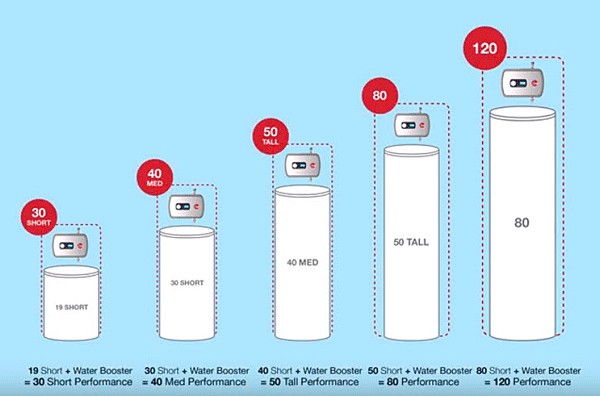
A tank water heater typically sends out water at 120 degrees Fahrenheit, but it can be set hotter when used with a tank booster. That “extra hot” water mixes with the cold water to get to 120 degrees, and the mixing of the cold and hot water increases the volume of hot water available. The illustration here shows a booster “boosts” the capacity of a 50-gallon tank water heater to the equivalent of an 80-gallon tank, with increases for other sizes as indicated.
The result is more heated water for use before the tank runs out. But while a water heater booster can be great for taking longer showers, it won’t provide instant hot water for those showers. For instant hot water at the faucet, the water either needs to be already heated in a pipe when it’s demanded or heated near where it’s demanded.
More Tips Regarding Instant Hot Water
1. Insulate Water Pipes
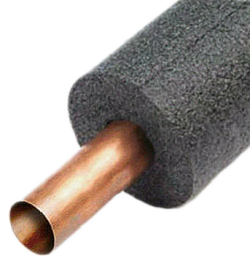 Insulation around hot water pipes will reduce heat loss while as water travels to the faucet. The insulation will also keep the pipes warm longer for the next time you need hot water.
Insulation around hot water pipes will reduce heat loss while as water travels to the faucet. The insulation will also keep the pipes warm longer for the next time you need hot water.
Will this get you instant hot water? No. But it will reduce the time you wait for hot water at the tap, and it can also reduce your energy bills.
2. Get Annual Maintenance for Your Water Heater
Maintenance of a water heater, whether it’s tank or tankless, is important to maximizing its lifespan. But a water heater that is not working efficiently will also need more time to deliver the heated water you need. In the case of a tank water heater, which most American homeowners still have, annual maintenance that includes flushing the tank, checking the anode rod and testing the temperature and pressure (T&P) relief valve helps ensure the water heater’s safety and efficiency.
3. Consult a Professional Plumber about Water Heater Installation
Installing a recirculation system is always a job for an experienced plumbing pro, and the other options for getting instant hot water at the faucet also require technical expertise.
Always use a licensed plumbing professional because water heaters that are improperly installed can be dangerous and carry the risk of explosion or starting a fire.
Conclusion
Whether we’re at the sink or the shower, we’ve all spent time waiting for hot water. We might be delayed only a minute or two, but it happens often enough that the time, and frustration, adds up. So, it’s no surprise that the experts in water heating have come up with some solutions.
- Recirculating Systems: Create a dedicated loop of heated water that is always circulating through the system and makes hot water immediately available at every faucet.
- Demand Systems: Use a pump attached to hot and cold water lines, and with the press of a button, cool water is sent back to the heater as hot water is brought to the faucet.
- Point-of-use Water Heaters: Available in tank and tankless versions, and both have the advantage of being close to where they provide heated water, eliminating the wait for water traveling through pipes.
If you’re interested in ways to get instant hot water at the faucet, you have options. Now that you know more about the possibilities, contact a licensed plumbing professional who can help decide what is right for your home – and can provide expert water heater installation that ensures the safety of you and your family.
Are you ready to finally have instant hot water at the faucet?
